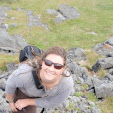The first time I have seen the field since last year was on Tuesday morning. The shadows from the early morning sun were cast over the hills. The prospect of hunting for the ‘vicious, stealthy’ coruro was thrilling. As ‘team degu’ began to piece together their telemetry equipment for a long day of tracking radio-collared degus, I stood silent reacquainted myself with the landscape. The steep hillside gave the coruros away. I could identify a network of colonies sweeping the across the farthest hills. I imagined how little heads would be popping in and out of the burrows, much like a whack-a-mole game at some arcade. Now, if only knocking them out with a rubber hammer would work as well as it does for the game.

The view from a coruro colony I found up the hillside. Not bad, huh?
My amazing coruro-tracking undergraduate Michael and I set off to flag active borrow openings. As we ranged across the hill where I had successfully trapped several individuals last year, I observed the coruros’ favored food, the bulb of Leucocoryne ixioides, a flowering plant locally called huilli, beginning to sprout from the earth. I look forward to seeing it flower in the austral spring. While flagging the active burrows among the colonies, I listened for the alarm calls of the fearsome coruro beneath the ground. A low-frequency repetitive bark sounding the retreat carried through the tunnels as my footsteps gave my presence away. I then sat quietly by one of the systems and within several minutes I observed 3 little heads pop out of the ground.
I also discovered a burrowing owl n est. The owls were beautiful. As I approached one called out at me and flew away. I found it humorous that not more than two meters from the juvenile owl who remained was a degu casually grazing. I also observed as I approached closer to degus on one side of the hill that they were diving into coruro tunnels to escape my presence. I thought of how this might complicate trapping. Later in the day, I ranged up and down the hillsides searching for new colonies. The hills were much steeper than I expected. I was exhausted by day’s end, but it was a great day to start the field season.
est. The owls were beautiful. As I approached one called out at me and flew away. I found it humorous that not more than two meters from the juvenile owl who remained was a degu casually grazing. I also observed as I approached closer to degus on one side of the hill that they were diving into coruro tunnels to escape my presence. I thought of how this might complicate trapping. Later in the day, I ranged up and down the hillsides searching for new colonies. The hills were much steeper than I expected. I was exhausted by day’s end, but it was a great day to start the field season.

the common degu (Octodon degus)
The second day in the field became wet and rainy shortly after we arrived. It was a steady light rain, so we worked on. I pressed further into the valley. I was about to turn back when I came upon a system that spanned many meters down into the valley. I was so excited I set off back to the truck to retrieve more flags. As I hiked back to the truck I heard the radio playing loudly. The degu team had finished for the day and was listening to the fútbol game on the radio. We headed in early, unloaded the equipment and I walked home from the university. I turned in early, falling asleep to the guitarist playing and singing on the corner pub. The irony of rainy days in Chile is that if the forecast calls for rain and we choose not to go into the field, it won’t rain. It was a beautiful, sunny Thursday. We decided enjoy the weather and to go out to lunch. We found a little restaurant to sit outside of. The waitresses were friendly and very charming. They had some wonderful ‘postres’ and Michael decided to order two slices of cake. The waitress thought he was joking. Michael nodded, “Si”. Thus he was dubbed “Flacito”, skinny little guy. The day was not wasted however, as it never is when you are learning new things about a language and culture. 








No comments:
Post a Comment